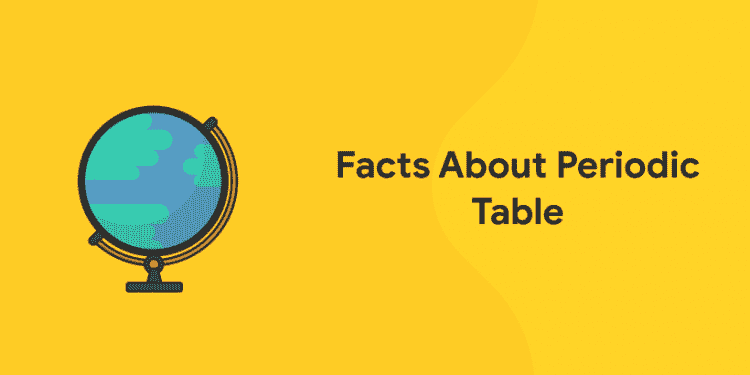Table of Contents
The periodic table is a table displaying the chemical elements. The periodic table, otherwise called the periodic table of elements, consists of chemical elements which are tabulated depending upon their atomic number, chemical properties and distribution of electrons in the atom/ molecule. Atoms are the smallest unit of matter that came into existence after the big bang 13.7 million years ago. A molecule is a combination of two or more atoms. A molecule is termed the smallest unit of substance, that retains the chemical composition and chemical properties of the substance. The periodic table consists of elements. Elements are arranged in the increasing atomic number. Atomic number is defined as the number of protons in the nucleus of the atom.
The periodic table comprises seven rows. These rows are called periods. The columns of the periodic table are known as groups. General distribution of the periodic table is in such a way that it contains metals to the left and nonmetals to the right of the periodic table. Each group, i.e elements coming under the same column in the periodic table exhibit similar chemical behaviours. In this article let us see about the periodic table and everything you might want to know.
Periodic Table – Overview
The periodic table is an organized display of all the elements. At present there are 118 discovered elements. Elements are the simplest substances that cannot be further broken down using chemical reactions. Instead elements can be changed to other elements by chemical methods and reactions.
The periodic table consists of 118 elements. The periodic table comprises 18 columns called the groups and 7 rows called periods. The elements having atomic numbers 1 to 94 are elements that occur naturally in nature. Rest of the elements i.e the elements having atomic numbers 95 to 118 are elements formulated in the laboratories, nuclear reactors or by nuclear explosions.
The initial discovery of the periodic table was done by Dimtri I Mendeleev in 1869. Professor Dmitri Mendleev published the periodic table in the mid 19th century. This was done in order to show a periodic trend of the elements. the periodic trends of the known elements. The Russian scientist also envisioned the properties of the elements that were not yet designed, which could fill in the gaps of the periodic table. His discoveries were of great value to the development of the field of chemistry. The periodic table that is available to us now is of great importance in analyzing chemical reactions. This periodic table is now being widely used in nuclear physics and other scientific fields.
Each chemical element in the periodic table has a unique atomic number, represented by “Z”. Isotopes are atoms of the same element with the same number of protons but different number of neutrons. Isotopes cannot be seen separately on the periodic table. Also in the periodic table a new row or period starts when the new shell has the first electron. And for elements falling under the same column the number of electrons in their outermost subshell will be the same
The first element in the table is Hydrogen and the last element/ 118th element is Oganesson. The newest edition to this table are elements with atomic numbers 113, 115, 117 and 118. These newest edition elements were made official by the International Union of Pure and Applied Chemistry in November 2016.
Stay tuned with entri for current affairs and GK Updates!
Elements and Their Classification
1: Who was the first woman President of India?
- The elements of the table are mainly classified into metals, semi metals and non metals.
- Metals includes alkali metals, alkaline earth metals, transition metals
- In the modern periodic table elements are grouped into 7 rows and 18 columns.
- Elements of the group 1, 2, 13, 14, 15, 16 and 17 are called main group elements
- Those elements falling under the group 3 to 12 are called transition elements
- Elements belonging to the 2 groups that can be seen at the bottom of the table are called lanthanides and actinides
- Elements with atomic numbers 58 to 71, i.e Cerium to Lutetium are called Lanthanides
- Elements with atomic numbers ranging from 90 to 103 i.e Thorium to Lawrencium are called Actinides.
- Lanthanides and Actinides are also called f block elements or inner transition elements
- Metals are conducting materials that are generally shiny. They form alloys when combined with other metals. When combined with non metals other than the noble gases they form ionic compounds
- Non metals can be coloured or colourless. They form compounds with other non metals
- Transition metals range between the metals and non metals. The properties of metalloids or transition metals lie in between metals and nonmetals.
- From the left end to the right end of the table we can witness a slow transition of elements from highly active alkali metals, then the alkaline earth metals which are considered less reactive. Then comes transition metals. After which comes the lanthanides and actinides.
- Noble gases are completely inert in nature
Click here to attempt general knowledge and general science quizzes!
Some Facts About the Periodic Table
- The periodic table that you have probably seen hanging on your classroom walls is essentially a big cheat sheet
- This was initially created by Professor Dmitri Mendeleev in 1869
- With the deadline nearing professor Mendleev was unable to describe all 63 elements. Hence he tabulated them based on atomic weights
- To find the atomic weight elements were broken to constituent atoms with the help of battery polarity
- The professor collected the atomic weights of each element in separate index cards, since he was fond of card games. He placed elements with similar atomic weights in a single suit. This was then arranged column wise in the order of increasing atomic weight. Thus he had a periodic law
- Mendeleev’s prediction regarding the atomic weights of elements such as gallium, scandium and germanium were accurate. These elements later filled in the vacant positions in the table.
- Since gases like helium, argon etc failed to fit into any category he denied the existence of these gases, but acknowledged regarding the same in 1902
- Noble gases constitute the 8th column in the table
- All the elements can now be distinguished based on their chemical properties. This is possible because of the protons and electrons present in them.
- Noble gases are inert gases. They have complete outer shells. Because of this they fail to have the tendency to lose or gain electrons.
- Semiconductor materials are formed using group 4 elements. These elements in group 4 readily bond with each other.
- Periodic table is maintained by International union for pure and applied chemistry
- Carbon is an element that is chemically very flexible.
- Radioactive elements such as uranium have unstable nuclei.
- Elements having atomic numbers above 91 are not natural elements. They are created in the laboratories or reactors etc with the help of other elements.
- The first element that was created or first man made element was technetium
- The element which is the lightest is hydrogen
- The heaviest element is Uranium. The atomic weight of uranium is 238.
- Noble gases are unreactive. However recent studies have brought out reactive compounds of noble elements such as radon, xenon and krypton.
- Metals constitute almost 75 percent of this table
- Allotropes are other forms of pure element. Diamond, graphite etc are allotropes of carbon
- Bromine and mercury are elements that are liquid at room temperature.
We hope that this quick article regarding the facts about the periodic table was helpful to you. Subscribe to entri in order to gain more information regarding various topics including general knowledge, current affairs and much more.














